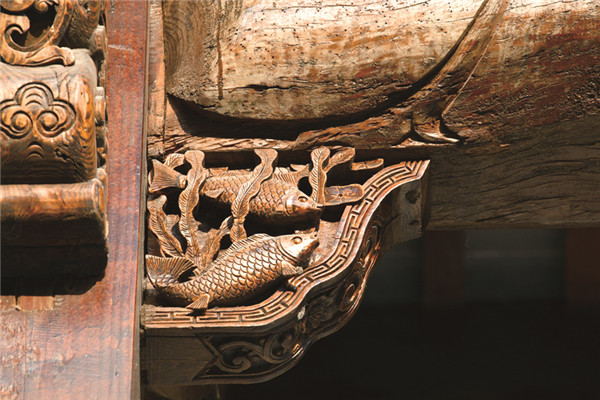Many parts of the Ahn Luh Zhujiajiao hotel were restored using the materials from antique collector Qin Tongqian's private collection. (Photo by Gao Erqiang/China Daily)

This new hotel in Shanghai may be situated 50 kilometers from the city center, away from the scenic Bund stretch, skyscrapers and big-name hotel chains, but spending just one night here will cost guests at least 3,000 yuan ($464).
Occupying more than 6,000 square meters in the quaint water town of Zhujiajiao, Ahn Luh Zhujiajiao offers guests the opportunity to stay in ancient manors that were restored using building materials from the collection of Qin Tongqian, a self-dubbed "antique house-collecting maniac".
The highlight of the hotel is a 14,000-square-meter and 10-meter-high mansion whose upturned eaves resemble the spreading wings of five pairs of phoenixes, which explains its name wufenglou (five phoenix mansion). This 600-year-old building is being used as the lobby of the hotel, expected to open to the public in May.
The hotel, which only has 35 rooms and suites, has already been fully booked on weekends during the soft opening period. One couple has even spent 500,000 yuan to book the entire hotel for their Chinese-themed wedding in May.
"Every luxury hotel in China wants to have some local elements. But this is one hotel that is truly Chinese. It's easy to build something modern and concrete, but it won't have the history and charm of a place like this," said Simon Kong, general manager of the hotel.
Ruan Yisan, a professor of urban planning at Shanghai's Tongji University and an ardent advocate of historic-building protection, said that while rebuilding old houses away from the place they were originally from actually violates the five principals of protection and preservation of antique buildings — original materials, original craftsmanship, original structure, original style and original environment — projects like Ahn Luh Zhujiajiao are a necessary evil if there is no better solution available.
According to Feng Jicai, chairman of the Chinese Folk Literature and Art Society, 300 villages in China are destroyed everyday because of urbanization. A total of 900,000 villages were destroyed over the past decade, the majority of which were ancient villages, classified as one or a cluster of hamlets that boast a minimum of 10 Chinese typical residences, temples of other types of architecture, and were naturally formed before 1911.
For a long time, the lack of finances has been the most common excuse used by local administrations, especially township governments, for the mishandling of antique houses. Zhang Zhu'an, a trader who made a windfall from this expensive hobby of his townfolk, would have agreed.
The former carpenter from Dongyang, Zhejiang province, where the largest quantity and highest quality of rosewood furniture in China is made, spotted the trend of antique house collecting about 10 years ago and decided to make a business out of it.
On an almost deserted piece of land in his hometown, the 64-year-old, together with a team of "dab hands", has been rebuilding houses with numbered bricks, wood panels and pillars. It usually takes at least three months for the team of 10 craftsmen to restore the decrepit homes. Middlemen like Zhang would charge 10 to 30 percent fee of the selling price after the reassembled house is shipped to the gardens of the country's richest people.
"A typical ancient house we work on looks like a biscuit that had fallen from the sixth floor. That's the sort of condition they are in before we start restoration works," said Zhang.
"It's undeniable that we are making a living from them, but there is nothing wrong. What we are doing now is definitely better than leaving them to crumble," argued Zhang, in response to critics that the houses lose their roots after they are dismantled and shipped around.
In 2012, the government of Suzhou, Jiangsu province, introduced a series of new regulations regarding the protection of old houses and villages, allowing private capital to be invested in historically important sites.
According to Yu Feng, vice-chairman of the Collection Association Club in Yiwu, Zhejiang province, there were no policies pertaining to the sale and resale of antique houses prior to the release of these regulations. He added that as long as a house was not listed by the local or central government as a protected relic, it would be up for grabs to the tens of thousands of collectors.
Yu, a logistics magnate from the city that is home to the world's largest trading center of small commodities like zips and socks, called antique houses "an ultimate item for any Chinese collector", as it makes for the perfect place to house the antique porcelainwares, furniture and paintings collected.
However, others have argued that the thriving house-collecting market is actually accelerating the demise of these antique buildings, seeing as to how collectors actively search for old homes to knock down and rebuild. This is aided by the fact that the residents of these old homes, most of whom struggle to make ends meet in life, would usually be more than happy to trade their homes for much-needed cash.


















































